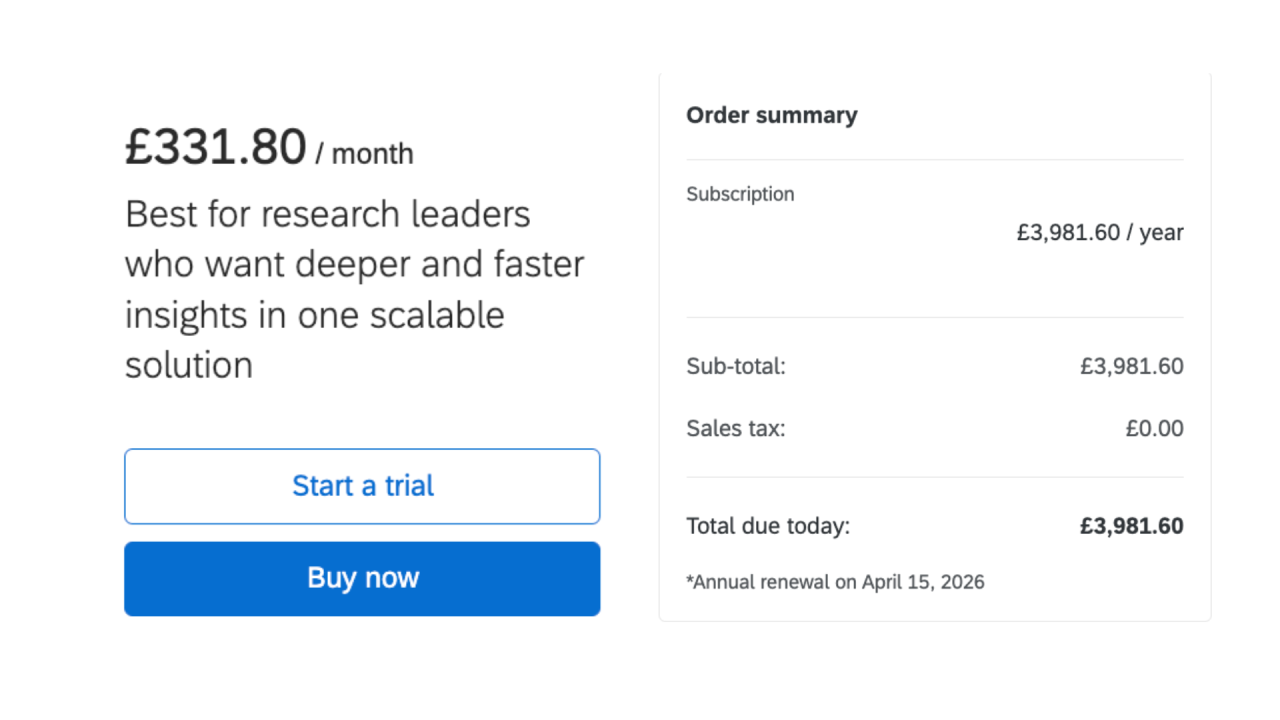A CX teardown of a leading experience management platform

A few weeks ago, I was in the market for a new CX tool.
As someone who works in customer experience and helps clients build journeys that actually work for real people, I was genuinely excited to try one of the world’s most well-known experience management platforms. Their promise? To help organisations “design and improve every experience”—through listening, empathy, and data.
But what followed wasn’t just a disappointing user journey—it was a case study in irony.
The brand promise: insight and empathy at scale
From the moment you land on the homepage, the brand radiates purpose. Every headline spoke to me; empowering businesses to become more customer-led. It talks about “understanding human emotions,” “personalising at scale,” and using feedback to drive better decisions. “If anyone get’s it, it’ll be them, right?”
Pricing that breeds distrust
I was ready to try it out—just a lightweight plan to experiment with some basic surveys. The pricing page said “from £331/month” and looked promising for us an agency
But the second I clicked "upgrade," things took a turn. The only option was annual payment (a classic SaaS tactic to create low-friction entry). No monthly plan. No pay-as-you-go. Just an upfront commitment for the entire year.
The monthly promise got me in the door, but the reality made me hesitate.

This isn’t just a UX oversight—it’s a trust-breaking moment. In CX terms, it’s a failure of expectation management.
The straw that broke the camel’s back? Finally unearthing a phone number for the sales team (honestly, it felt like solving a mini escape room). I got through, explained the situation—fully expecting I'd just missed a setting or taken a wrong turn somewhere. But nope. Deadpan response, zero flexibility, and not even a whiff of a paid monthly trial. Just a hard “no,” delivered with the enthusiasm of someone who’d clearly rather be anywhere else. It takes a lot to leave me speechless—but wow. Mission accomplished.
The feedback is loud - but ignored
For a company whose product is built on capturing customer sentiment, they appear to be selectively deaf to their own users.
Out of curiosity (and maybe a little self-validation), I took a trip over to Trustpilot—where the platform’s sitting at a 1.3/5 “Poor” rating. Turns out, it’s not just little old me feeling the sting. There’s a whole crowd of equally frustrated customers wondering how a company built on “experience” got theirs so wrong.
Common complaints include:
Rigid, opaque pricing.
Incompetent sales team.
Limited support responsiveness.
Bots are useless, infinite stream of questions and errors.
Scam, folks who answered surveys report they weren’t paid / were ripped off.
Here are just a few anonymised quotes from verified users:
Incompetent sales team. Tried to get in touch with someone from the sales team who could tell me how much their packages cost. They have been unable to provide me with this simple information for 3 weeks now. I called them numerous times and emailed back and forth with them. How hard can it be to sell me something? Outrageously bad service!
To say I am disappointed for spending money on this useless service would be a total understatement. In all my years of working with tech vendors I have never interacted with a less responsive and non-customer focused crowd. Complete non-responsiveness to several tickets, as well as system issues (via two different browsers).
I contacted the support team for basic assistance and they were entirely unhelpful or apologetic. The agent disconnected me without resolving or notice. Sadly, this is not the first time l've received lackluster response from them and their default seems to be to leave users to figure things out on their own with absolutely no assistance.
The customer experience gap
Here’s a snippet of where this platform's experience breaks down—and what it reveals about the risk of misaligned CX strategy:
Gap | Description |
Messaging vs. Reality | Pricing is shown monthly, but enforced annually—this erodes trust. |
Sales as a Barrier | Sales reps limit options rather than adapt to user needs—causing friction instead of guiding. |
Feedback Ignored | Despite being a feedback platform, there’s little evidence of user concerns shaping the experience. |
Final thought
I started out curious and excited. I ended up surprised (for all the wrong reasons) and frustrated.
That’s the power—and danger—of customer experience. You can spend millions on your platform and positioning, but your real CX is what people feel when they try to use your product, contact your team, or pay for your service.
And in this case, the experience management platform forgot the most important thing:
Listen to your own customers.
If you’re seeing signs like sales dips, customer retention problems, negative reviews then bad news, you might have a customer experience problem, good news is you don’t have to figure it out alone.
Our Service Safari product is designed to help.
We independently assess your customer experience end-to-end — giving you an honest, outside-in view that removes the blinkers and breaks you out of the service bubble. No assumptions. No bias. Just real, practical insight you can act on.
If you'd like a fresh pair of eyes on your experience, get in touch — we'd love to help.